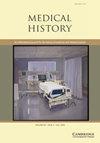Fluid deafness: earwax and hardness of hearing in early modern Europe
IF 1.1
2区 哲学
Q4 HEALTH CARE SCIENCES & SERVICES
引用次数: 0
Abstract
Abstract This article discusses hearing disability in early modern Europe, focusing on medical ideas to demonstrate a profound shift in thinking about deafness over the course of the eighteenth century. Scholars have previously described changes in the social status of the deaf in the eighteenth century, pointing at clerics’ sympathy for the deaf and philosophers’ fascination with gestures as the origin of language, but there is remarkably little scholarship on the growing interest in deafness and hardness of hearing by physicians. From the seventeenth century onwards, however, medical men investigated earwax and mucus in the Eustachian Tube and developed theories about the propagation of sound waves via fluid airs and nervous juices in relation to hearing and deafness. This article argues that this focus on fluids brought about a new medical understanding of auditory perception, which viewed hearing and deafness not as dichotomous but as states along a continuous spectrum. As such, this article offers a new perspective on the study and treatment of hearing difficulties in early modern Europe, arguing that there was no solid dividing line between deafness and hearing; if anything, it was permeable and unstable.液体性耳聋:近代早期欧洲的耳垢和听力硬度
摘要本文讨论了现代早期欧洲的听力障碍,重点讨论了十八世纪关于耳聋的深刻转变。学者们以前曾描述过18世纪聋人社会地位的变化,指出神职人员对聋人的同情,哲学家对手势作为语言起源的迷恋,但关于医生对耳聋和听力障碍日益增长的兴趣的学术研究却少得可怜。然而,从17世纪开始,医生研究了耳咽管中的耳垢和粘液,并提出了声波通过流体空气和神经液传播与听力和耳聋有关的理论。这篇文章认为,这种对液体的关注带来了听觉感知的一种新的医学理解,它认为听力和耳聋不是二分的,而是沿连续谱的状态。因此,本文为现代早期欧洲的听力障碍研究和治疗提供了一个新的视角,认为耳聋和听力之间没有明确的界限;如果说有什么区别的话,那就是它是可渗透的,不稳定的。
本文章由计算机程序翻译,如有差异,请以英文原文为准。
求助全文
约1分钟内获得全文
求助全文
来源期刊

Medical History
医学-科学史与科学哲学
CiteScore
1.60
自引率
0.00%
发文量
25
审稿时长
>12 weeks
期刊介绍:
Medical History is a refereed journal devoted to all aspects of the history of medicine and health, with the goal of broadening and deepening the understanding of the field, in the widest sense, by historical studies of the highest quality. It is also the journal of the European Association for the History of Medicine and Health. The membership of the Editorial Board, which includes senior members of the EAHMH, reflects the commitment to the finest international standards in refereeing of submitted papers and the reviewing of books. The journal publishes in English, but welcomes submissions from scholars for whom English is not a first language; language and copy-editing assistance will be provided wherever possible.
 求助内容:
求助内容: 应助结果提醒方式:
应助结果提醒方式:


